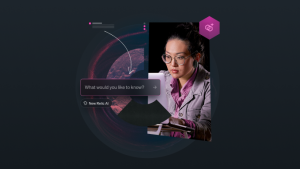AI-gestützte Incident Response muss für die gesamte Engineering- und SRE-Community zugänglich sein. Gerade für Kolleg:innen im Bereitschaftsdienst möchten wir dies mit sofortiger Wirkung in die Tat umsetzen, und so ist Applied Intelligence nun automatisch Teil von New Relic One für alle Nutzer:innen mit Komplettlizenz!
Denn Incidents wollen rasch adressiert werden – nicht zuletzt natürlich auch im Interesse von Kundenbeziehungen, Umsatzchancen und Reputation. Mit Applied Intelligence identifizieren Engineering-Teams anhand von AIOps-Features Probleme in der Entstehung, minimieren Alert-Rauschen und finden Fehlerursachen in kürzester Zeit.
Mehr als nur Incident Response
Applied Intelligence liefert unseren Nutzer:innen mit Komplettlizenz alle Features und Möglichkeiten für raschere Fehlerbehebung, weniger Alert-Rauschen und mehr Stabilität für ihre Anwendungen und Services allgemein.
Am deutlichsten erkennbar wird die UI-Anpassung am neuen Navigationsmenü links von „Alerts & AI“ mit nun klarerem Mapping für Ihre Incident Response. Aber auch weitere neue Features werden Ihnen auffallen, so etwa:
- Workflows bieten unseren Kund:innen flexibles Incident-Routing zu den richtigen Teams anhand von Incident Specs über Ticket- und Benachrichtigungstools wie ServiceNow und JIRA. Mit Custom-Webhooks lassen sich außerdem weitere Services integrieren.
- Daten-Enrichment ermöglicht Abfragen in NRDB, macht Detail-Informationen erfassbar und vordefinierte Parameter einstellbar. So erweitern Sie Ihre Alerts automatisch um zusätzlichen Kontext, bevor sie Ihren Bereitschaftsteams übergeben werden. Hierdurch entsteht eine größere Informations-Spannbreite, über die sich Dringlichkeit und geschäftliche Auswirkungen klarer ablesen lassen.
- Bidirektionale Integrationen für JIRA und ServiceNow machen Custom-Felder möglich und liefern zusätzliche Transaktionssicherheit. Aktuell in der Entwicklung sind zudem Integrationen für E-Mail-Clients, PagerDuty, AWS EventBridge sowie Microsoft Teams.
Alle Nutzer:innen von New Relic One mit Komplettlizenz erhalten ohne Zusatzkosten Zugriff auf Applied Intelligence. Bestehende Kund:innen nutzen hierzu die Registerkarte Alerts & AI im oberen Navigationsbereich von New Relic One.
Auch neuen Nutzer:innen von New Relic steht AIOps natürlich offen. Registrieren Sie sich hierzu einfach für ein kostenloses Konto. Weitere Informationen erhalten Sie in der Dokumentation für New Relic Applied Intelligence.
This blog post contains “forward-looking” statements, as that term is defined under the federal securities laws, including but not limited to statements regarding expected features and benefits of New Relic’s free access to AIOps, anticipated improvements to the incident response experience, expected features including Workflows, Enrichment, bi-directional integrations, and future integrations, and any anticipated benefits, results and future opportunities related thereto. The achievement or success of the matters covered by such forward-looking statements are based on New Relic’s current assumptions, expectations, and beliefs and are subject to substantial risks, uncertainties, assumptions, and changes in circumstances that may cause New Relic’s actual results, performance, or achievements to differ materially from those expressed or implied in any forward-looking statement. Further information on factors that could affect New Relic’s financial and other results and the forward-looking statements in this post is included in the filings New Relic makes with the SEC from time to time, including in New Relic’s most recent Form 10-Q, particularly under the captions “Risk Factors” and “Management’s Discussion and Analysis of Financial Condition and Results of Operations.” Copies of these documents may be obtained by visiting New Relic’s Investor Relations website at http://ir.newrelic.com or the SEC’s website at www.sec.gov. New Relic assumes no obligation and does not intend to update these forward-looking statements, except as required by law.
Die in diesem Blog geäußerten Ansichten sind die des Autors und spiegeln nicht unbedingt die Ansichten von New Relic wider. Alle vom Autor angebotenen Lösungen sind umgebungsspezifisch und nicht Teil der kommerziellen Lösungen oder des Supports von New Relic. Bitte besuchen Sie uns exklusiv im Explorers Hub (discuss.newrelic.com) für Fragen und Unterstützung zu diesem Blogbeitrag. Dieser Blog kann Links zu Inhalten auf Websites Dritter enthalten. Durch die Bereitstellung solcher Links übernimmt, garantiert, genehmigt oder billigt New Relic die auf diesen Websites verfügbaren Informationen, Ansichten oder Produkte nicht.



